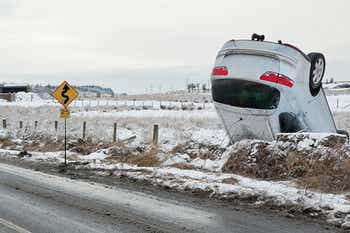It can happen in the blink of an eye. Airbags deploy and glass breaks and, when the smoke clears, you realize you’ve just been involved in a car collision.
Many of us have experienced or witnessed a car accident within our lifetimes. It’s estimated that the average driver will file an accident claim about once every 18 years, according to Fox Business News. This means the average driver will be involved in four accidents during the course of his or her life.
These accidents can range from small fender benders to more serious collisions that could result in serious injury or even death. The Auto Insurance Center recently conducted a study into the top causes of fatal collisions using data the National Highway Traffic Safety Administration (NHTSA) compiled from 2009 to 2013.
Here are the top five causes of deadly collisions and some suggestions on how to avoid them:
1. Failure to Stay in the Proper Lane
It’s important to be conscious of your car’s position on the road. If you’re fiddling with the radio, GPS or phone, or engaging in other behaviors that take your attention from the road, you may inadvertently turn the wheel or drift into another lane. Be aware of other drivers who may be distracted, too. If you’re not paying attention, you may not have enough time to react.
Some vehicles are equipped with technology that provides an alert when crossing over painted lines in the road without the use of a turn signal, notifying inattentive drivers to draw their focus back to the road ahead. However, this technology is a driver’s aid and is not a substitute for keeping your attention on driving with both hands on the wheel.
2. Improper Turns or Erratic Lane Changes
Quickly switching or ping-ponging between lanes is an easy way to confuse and irritate other drivers, especially when neglecting to use a turn signal. A 2014 national study conducted by the Society of Automotive Engineers found that drivers neglect to use a turn signal during lane changes nearly 50 percent of the time, and when making a turn drivers fail to signal for 25 percent of their turns.
It doesn’t take a rocket scientist to understand that if you need to change lanes or make a turn, you need to use your blinker…every time. It could save you a lot of money on repair costs you don’t have to make, but more importantly, it could also save your life.
3. Reckless or Distracted Driving
Reckless driving is defined as operation of an automobile in a dangerous manner, including speeding (or going too fast for the conditions, even if you’re within the posted speed limit), driving after drinking, having too many passengers in the car, cutting in and out of traffic, failing to yield to other vehicles, and other negligent acts. Distracted driving includes activities like driving while eating, texting or talking on the phone. Both are dangerous habits that can put yourself and others at serious risk.
AT&T surveyed smartphone users and found that around 70 percent of respondents used their phones while driving. Sixty one percent admitted to texting – a disturbing trend as the National Safety Council estimates that cell phones play a role in 27 percent of all car crashes.
Be considerate of others and think about how your actions can impact them. Set your GPS ahead of time and if you must make a phone call, text or eat, wait until you’re parked at your destination or find a safe spot to pull over before completing your task. Find constructive ways to diffuse road rage, like curbing your anger by listening to your favorite songs and if you do encounter a reckless or distracted driver, try to avoid the use of your horn and inappropriate gestures as you’ll only make the situation worse.
4. Failure to Yield
It’s important to know the rules of the road.
For example, who should yield first at a blinking yellow light, in a roundabout, or at a four-way stop? Or, what’s the proper way to merge onto a freeway?
The general rule of thumb is that the first car to arrive has the right of way and all subsequent drivers yield – this is the case at both roundabouts and four-way stops. Yield to the driver on your right when multiple cars simultaneously reach a four-way stop.
Drivers entering a roundabout must look left and yield to cars already in the roundabout. If the roundabout has more than one lane, make sure to look both ways. Always check for traffic gaps before merging. Blinking yellow lights signal drivers to proceed with caution. Yield to cars executing turns across traffic and, conversely, wait for traffic to break to make a turn.
Failing to yield can cause accidents when drivers with the right of way are surprised by an unexpected vehicle in their path. Brush up on the rules of the road and, when in doubt, yield. Also, staying aware of other drivers will give you time to react and avoid a collision.
5. Failure to Obey Traffic Signs
Traffic signs are there to direct driving behavior – they inform us to stop, slow for a sharp turn and they tell us the appropriate speed limit, among other things.
Failure to obey traffic signs will often result in a dangerous situation for you or others on the road. For example, running a stop sign on a busy street could lead to a serious collision. If it’s been a while since you took your driver’s test, brush up on your road sign knowledge by taking this quiz.
The most important safety feature in any vehicle is an attentive driver. Before starting the vehicle, make a commitment to eliminate in-car distractions and remain focused on the task at hand – driving. You never know who else might be distracted, so where possible, take your safety into your own hands.


